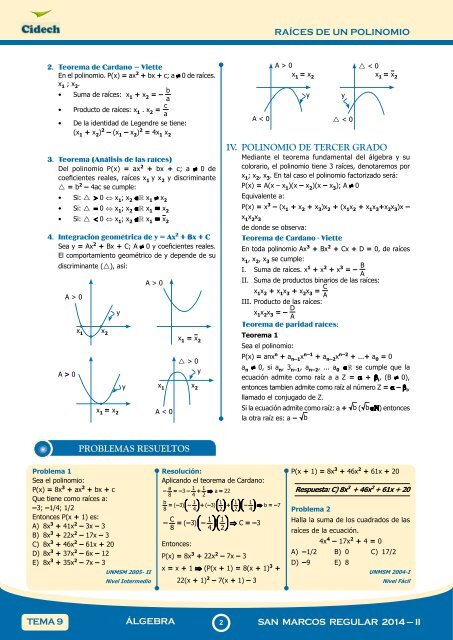CLASE SEMANA 09
You also want an ePaper? Increase the reach of your titles
YUMPU automatically turns print PDFs into web optimized ePapers that Google loves.
RAÍCES DE UN POLINOMIO<br />
A > 0 i < 0<br />
2. Teorema de Cardano – Viette<br />
x 1 x 2<br />
Teorema de paridad raíces:<br />
x 1 = x<br />
Teorema 1<br />
2<br />
En el polinomio. P(x) = ax 2 + bx + c; a ≠ 0 de raíces.<br />
x 1 = x 2 x 1 = x 2<br />
x 1 ; x 2 .<br />
• Suma de raíces: x 1 + x 2 = – b a<br />
y y<br />
• Producto de raíces: x 1 . x 2 = c a<br />
A < 0 i < 0<br />
• De la identidad de Legendre se tiene:<br />
(x 1<br />
+ x 2<br />
) 2 – (x 1<br />
– x 2<br />
) 2 = 4x 1<br />
x 2<br />
IV. polInomIo de teRceR gRado<br />
3. Teorema (Análisis de las raíces)<br />
Del polinomio P(x) = ax 2 + bx + c; a ≠ 0 de<br />
coeficientes reales, raíces x 1 y x 2 y discriminante<br />
i = b 2 – 4ac se cumple:<br />
Mediante el teorema fundamental del álgebra y su<br />
colorario, el polinomio tiene 3 raíces, denotaremos por<br />
x 1 ; x 2 , x 3 . En tal caso el polinomio factorizado será:<br />
P(x) = A(x – x 1 )(x – x 2 )(x – x 3 ); A ≠ 0<br />
• Si: i > 0 ⇔ x 1 ; x 2 ∈ x 1 ≠ x 2<br />
Equivalente a:<br />
• Si: i = 0 ⇔ x 1 ; x 2 ∈ x 1 = x 2<br />
P(x) = x 3 – (x 1 + x 2 + x 3 )x 2 + (x 1 x 2 + x 1 x 3 +x 2 x 3 )x –<br />
• Si: i < 0 ⇔ x 1 ; x 2 ∉ x 1 = x 2<br />
x 1<br />
x 2<br />
x 3<br />
de donde se observa:<br />
4. Integración geométrica de y = Ax 2 + Bx + C Teorema de Cardano - Viette<br />
Sea y = Ax 2 + Bx + C; A ≠ 0 y coeficientes reales. En toda polinomio Ax 3 + Bx 2 + Cx + D = 0, de raíces<br />
El comportamiento geométrico de y depende de su<br />
x 1<br />
, x 2<br />
, x 3<br />
se cumple:<br />
discriminante (i), así:<br />
I. Suma de raíces. x 1 + x 2 + x 3 = – B A<br />
A > 0<br />
II. Suma de productos binarios de las raíces:<br />
x 1 x 2 + x 1 x 3 + x 2 x 3 = C<br />
A > 0<br />
A<br />
III. Producto de las raíces:<br />
x 1 = x Si la ecuación admite como raíz: a + b ( b∈) entonces<br />
2 A < 0<br />
la otra raíz es: a – b<br />
y<br />
x 1 x 2 x 3 = – D A<br />
Sea el polinomio:<br />
P(x) = anx n + a<br />
i > 0<br />
n–1<br />
x n–1 + a n–2<br />
x n–2 + ...+ a 0<br />
= 0<br />
a<br />
A > 0<br />
y<br />
n ≠ 0, si a n , 3 n–1 , a n–2 , ... a 0 ∈ se cumple que la<br />
ecuación admite como raíz a a Z = a + b i , (B ≠ 0),<br />
y x 1 x 2<br />
entonces tambien admite como raíz al número Z = a – b i ,<br />
llamado el conjugado de Z.<br />
pRoBlemas Resueltos<br />
Problema 1<br />
Sea el polinomio:<br />
P(x) = 8x 3 + ax 2 + bx + c<br />
Que tiene como raíces a:<br />
–3; –1/4; 1/2<br />
Entonces P(x + 1) es:<br />
A) 8x 3 + 41x 2 – 3x – 3<br />
B) 8x 3 + 22x 2 – 17x – 3<br />
C) 8x 3 + 46x 2 – 61x + 20<br />
D) 8x 3 + 37x 2 – 6x – 12<br />
E) 8x 3 + 35x 2 – 7x – 3<br />
UNMSM 2005- II<br />
Nivel Intermedio<br />
Resolución:<br />
Aplicando el teorema de Cardano:<br />
a 1 1<br />
– =– 3 – + ⇒ a = 22<br />
8 4 2<br />
b ⎛ 1⎞ ⎛1⎞ ⎛1⎞⎛ 1⎞ = (– 3) ⎜ – ⎟ + (– 3) ⎜ ⎟ + ⎜ ⎟⎜ – ⎟ ⇒ b =– 7<br />
8 ⎝ 4⎠ ⎝2⎠ ⎝2⎠⎝ 4⎠<br />
C ⎛ 1⎞⎛1⎞ – = (– 3) ⎜ – ⎟⎜ ⎟⇒<br />
C =– 3<br />
8 ⎝ 4⎠⎝2⎠<br />
Entonces:<br />
P(x) = 8x 3 + 22x 2 – 7x – 3<br />
x = x + 1 ⇒ (P(x + 1) = 8(x + 1) 3 +<br />
22(x + 1) 2 – 7(x + 1) – 3<br />
P(x + 1) = 8x 3 + 46x 2 + 61x + 20<br />
Respuesta: C) 8x 3 + 46x 2 + 61x + 20<br />
Problema 2<br />
Halla la suma de los cuadrados de las<br />
raíces de la ecuación.<br />
4x 4 – 17x 2 + 4 = 0<br />
A) –1/2 B) 0 C) 17/2<br />
D) –9 E) 8<br />
UNMSM 2004-I<br />
Nivel Fácil<br />
TEma 9<br />
áLGEbra<br />
2<br />
2 san marcos rEGULar 2014 – II


















